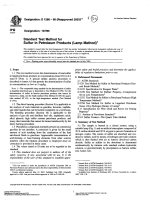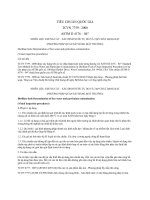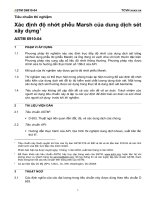Astm d 563 88 (1996)e1
Bạn đang xem bản rút gọn của tài liệu. Xem và tải ngay bản đầy đủ của tài liệu tại đây (34.92 KB, 2 trang )
Designation: D 563 – 88 (Reapproved 1996)e1
An American National Standard
AMERICAN SOCIETY FOR TESTING AND MATERIALS
100 Barr Harbor Dr., West Conshohocken, PA 19428
Reprinted from the Annual Book of ASTM Standards. Copyright ASTM
Standard Test Method for
Phthalic Anhydride Content of Alkyd Resins and Resin
Solutions1
This standard is issued under the fixed designation D 563; the number immediately following the designation indicates the year of
original adoption or, in the case of revision, the year of last revision. A number in parentheses indicates the year of last reapproval. A
superscript epsilon (e) indicates an editorial change since the last revision or reapproval.
This standard has been approved for use by agencies of the Department of Defense.
e1 NOTE—Keywords were added editorially in October 1996.
5. Reagents
5.1 Purity of Reagents—Reagent grade chemicals shall be
used in all tests. Unless otherwise indicated, it is intended that
all reagents shall conform to the specifications of the Committee on Analytical Reagents of the American Chemical Society,
where such specifications are available.3 Other grades may be
used, provided it is first ascertained that the reagent is of
sufficiently high purity to permit its use without lessening the
accuracy of the determination.
5.2 Purity of Water—Unless otherwise indicated, references
to water shall be understood to mean reagent water as defined
by Type II of Specification D 1193.
5.3 Alcohol-Benzene Wash Solution—Mix one volume of
absolute ethyl alcohol (Note 2) with three volumes of benzene.
1. Scope
1.1 This test method covers the determination of the phthalic anhydride content (Note 1) of alkyd resins and resin
solutions, including those containing styrene.
NOTE 1—This test method is not applicable for the determination of
phthalic anhydride in alkyd resins containing other dibasic acids such as
maleic or fumaric, or modifying agents such as urea, melamine, and
phenolic resins.
1.2 This standard does not purport to address all of the
safety concerns, if any, associated with its use. It is the
responsibility of the user of this standard to establish appropriate safety and health practices and determine the applicability of regulatory limitations prior to use.
2. Referenced Documents
2.1 ASTM Standards:
D 1193 Specification for Reagent Water2
NOTE 2—The alcohol may be denatured, formula 2B, but must be
absolute.
5.4 Benzene.
5.5 Ether—Anhydrous analytical reagent-grade ether.
5.6 Hydrochloric Acid, Standard (0.1 N).
5.7 Potassium Hydroxide, Alcoholic Solution—Dissolve 66
g of reagent-grade potassium hydroxide (KOH) in 1 L of
absolute ethyl alcohol (Note 2). Filter just before use.
3. Significance and Use
3.1 The phthalic anhydride content of alkyd resins controls
the properties of the final film.
4. Apparatus
4.1 Flask and Condenser—A 500-mL Erlenmeyer flask
fitted with an air-cooled glass reflux condenser 30 in. (760 mm)
in length. The connection between the flask and condenser
shall be a 24/40 standard taper ground-glass joint.
4.2 Water Bath.
4.3 Fritted-Glass Filter Crucible, fine or medium porosity,
of 30-mL capacity.
4.4 Desiccator, containing concentrated H2SO4 (sp gr 1.84)
as the desiccant.
4.5 Filter Flasks.
4.6 Crucible Holder.
6. Procedure
6.1 Weigh by difference, from a closed container into the
500-mL Erlenmeyer flask, a specimen of resin or resin solution
sufficient to yield from 0.8 to 1.2 g of potassium alcohol
phthalate. Add 150 mL of benzene, warming slightly on the
steam bath if necessary, to effect solution. Add 60 mL of
alcoholic KOH solution and attach the condenser. Place the
flask in a water bath to a depth approximately equal to that of
the contents of the flask. Warm the bath, maintaining a
temperature of 40°C for 1 h, then gradually raise the temperature until the alcoholic solution boils gently. Reflux for 11⁄2 h.
1
This method is under the jurisdiction of ASTM Committee D-1 on Paint and
Related Coatings, Materials, and Applications and is the direct responsibility of
Subcommittee D01.33 on Polymers and Resins.
Current edition approved May 27, 1988. Published October 1988. Originally
published as D 563 – 40 T. Last previous edition D 563 – 80.
2
Annual Book of ASTM Standards, Vol 11.01.
3
Reagent Chemicals, American Chemical Society Specifications, American
Chemical Society, Washington, DC. For suggestions on the testing of reagents not
listed by the American Chemical Society, see Analar Standards for Laboratory
Chemicals, BDH Ltd., Poole, Dorset, U.K., and the United States Pharmacopeia
and National Formulary, U.S. Pharmacopeial Convention, Inc. (USPC), Rockville,
MD.
1
D 563
6.2 Remove the flask from the bath and wash down the
inside of the condenser with a few millilitres of alcoholbenzene wash solution. Remove the condenser, cap the flask
with the soda-lime guard tube, and cool by means of running
water or an ice bath.
6.3 When cool, filter immediately and as rapidly as possible,
through a fritted-glass crucible that previously has been tared,
using the alcohol-benzene wash solution for transferring the
precipitate and washing the reaction flask. Wash the precipitate
with successive portions of alcohol-benzene wash solution
until a few millilitres of washings collected in a second suction
flask are no longer alkaline to phenolphthalein. (Normally
about 75 mL of wash solution are sufficient.) Do not allow air
to be drawn through the crystals, as they are hygroscopic.
Finally pour 25-mL of ether into the crucible and draw through
the precipitate with the aid of suction.
6.4 Wipe the outer surface of the crucible with a clean cloth
and place in a gravity convection oven at 60°C for 1 h (Note 3).
Cool to room temperature in a desiccator and weigh.
may be a source of error. If a correction for K2CO3 is desired,
proceed as follows: Dissolve the weighed precipitate in about
50 mL of distilled water that has been neutralized to phenolphthalein. Add 3 to 4 drops of phenolphthalein indicator
solution, and if the solution is alkaline, titrate with 0.1 N HCl.
NOTE 3—The precipitate is the alcoholate (C6H4(COOH)2·(C2H5OH)),
and the alcohol of crystallization will be slowly driven off on prolonged
heating. It is safe, however, to dry the alcoholate at temperatures up to
60°C for as long as 1 h.
8. Precision and Bias
7. Calculation
7.1 Calculate the percent of phthalic anhydride A in the
specimen as follows:
K 5 VN 3 0.1382
A 5 @~~P 2 K! 3 0.5136!/S# 3 100
where:
K 5 correction for K2CO3 (if determined), g,
V 5 HCl used for titration (see 6.5), mL,
N 5 normality of HCl,
P 5 potassium alcohol phthalate (see 6.5), g, and
S 5 specimen used, g.
8.1 Precision and bias are being determined.
9. Keywords
6.5 Correction for Carbonates—Coprecipitation of potassium carbonate (K2CO3) with the potassium alcohol phthalate
9.1 alkyd resins; phthalic anhydride content; resin solutions
The American Society for Testing and Materials takes no position respecting the validity of any patent rights asserted in connection
with any item mentioned in this standard. Users of this standard are expressly advised that determination of the validity of any such
patent rights, and the risk of infringement of such rights, are entirely their own responsibility.
This standard is subject to revision at any time by the responsible technical committee and must be reviewed every five years and
if not revised, either reapproved or withdrawn. Your comments are invited either for revision of this standard or for additional standards
and should be addressed to ASTM Headquarters. Your comments will receive careful consideration at a meeting of the responsible
technical committee, which you may attend. If you feel that your comments have not received a fair hearing you should make your
views known to the ASTM Committee on Standards, 100 Barr Harbor Drive, West Conshohocken, PA 19428.
2









